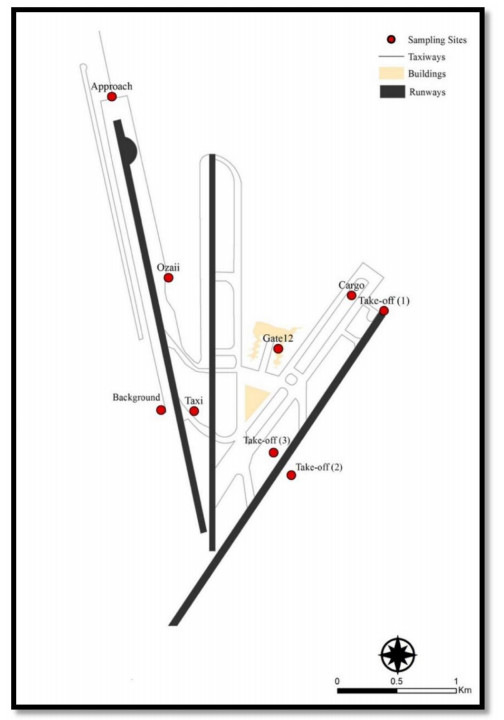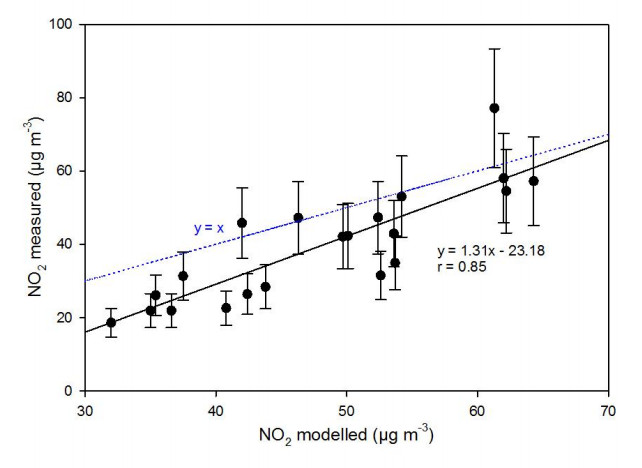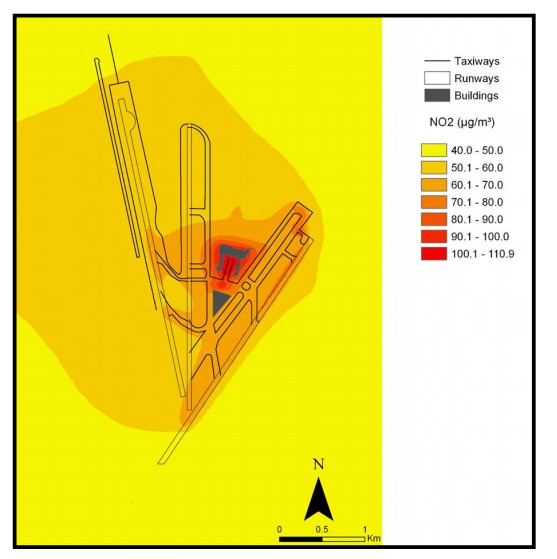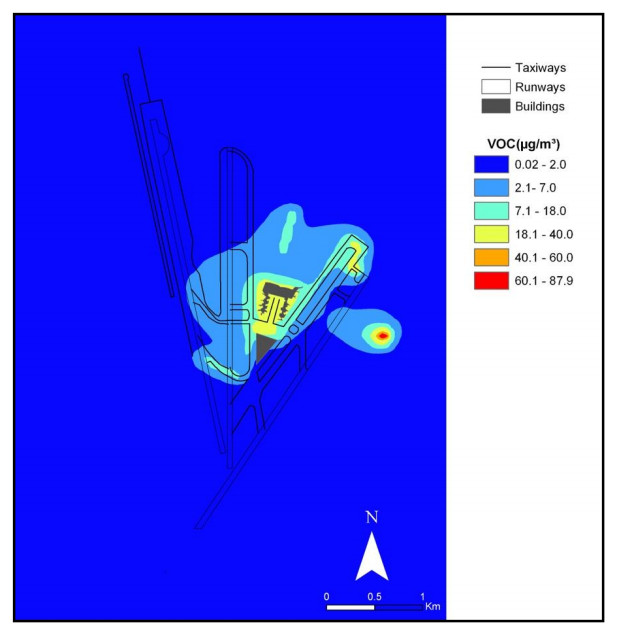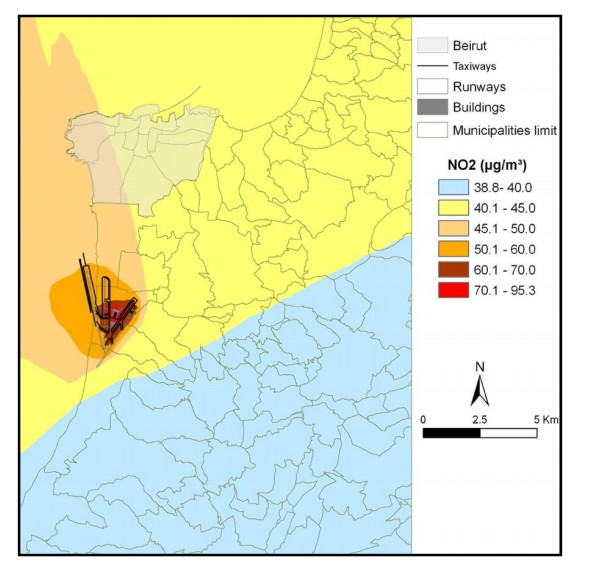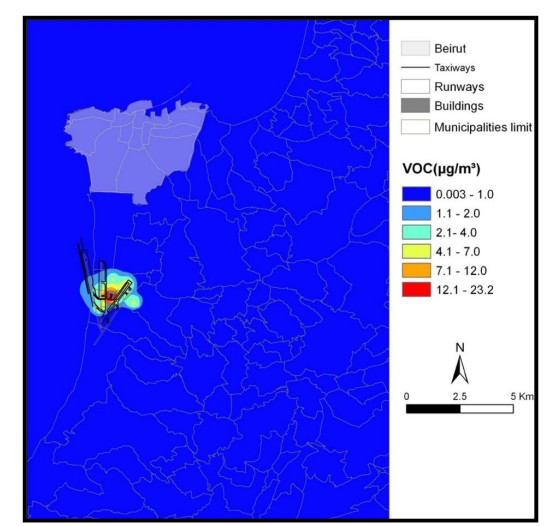1.
Introduction
Air transport plays a major role in driving sustainable economic and social development, carrying over 4.3 billion passengers and 58 million tons of freight annually [1]. Unlike most transportation modes, air transport covers great distances at a variety of altitudes. Its expected yearly growth projections (5%) [2] will result in increased concentrations of atmospheric pollutants affecting the global climate and local air quality (LAQ) near airports, thereby posing a hazard to the environment [3,4,5] and public health (nearby residents airport workers, and passengers) if sustainable growth measures are not enacted [6,7,8,9,10,11].
Over the last decade, many studies [12,13] have focused on assessing the contribution of airport operations to air quality degradation, which is a prerequisite for implementing mitigation measures by stakeholders. In fact, it is not easy to generalize an airport's contribution to the degradation of LAQ as it is dependent on each airport's own characteristics, i.e., location, surrounding geography and topography, layout, meteorology, traffic, etc. [12]. Despite this ascertainment, the majority of the evidence has indicated that pollutant concentrations are generally elevated in the vicinity of airports and that contributions were significant up to 1 km and relatively smaller 2–3 km away [13,14,15,16]. For example, using measured data, Carslaw et al. [17] found that although London-Heathrow Airport, which is situated in West London approximately 25 km from Central London, is an important source of nitrogen oxide (NOx) emissions, and concentrations observed near the airport are mainly attributed to road traffic. At the airport boundary, the airport contribution to the annual mean nitrogen dioxide (NO2) concentrations was estimated to be 27%. Up to a 1–1.5 km distance, the contribution of airport activity to NOx was found to range from 12 to 14%. NOx emissions related to air traffic were detected at least 2.6 km from the airport. At background locations 2–3 km downwind of the airport, the upper limit of the airport contribution was estimated to be less than 15%, i.e., 10 µg∙m-3. Also, dispersion models have been used to evaluate the local impact of airport activity. A study on Manchester Airport, which was conducted using an atmospheric dispersion modelling system (ADMS), showed that the main contributor to ambient NOx was traffic emissions associated with airport activity [18]. The model results showed that beyond a 200 m altitude, the aircraft emissions have little impact on ground-level concentrations. The model ADMS has also been used to quantify the temporal and spatial contributions of NOx due to aircraft and road traffic around Heathrow airport [19]. The results also showed that NOx emissions related to road traffic around the airport exceeded those from air traffic, although a relevant percentage of local traffic is caused by the airport operations. Westerdahl et al. [20] studied the effects of the emissions of Los Angeles International Airport on the LAQ situated to the east of the Pacific Ocean and the Santa Monica Bay; they reported that the airport and ground activities, where aircraft landing and take off take place, influence the concentration levels observed near the airport. At Athens International Airport [21], which is surrounded by mountains at three sides and a sea at the fourth, emissions calculated by applying an emissions and dispersion modeling system (EDMS) were found to be in good agreement with the measured data. The results confirmed that the PM10 and SO2 concentrations were lower than the limit values, while the NO2 concentrations were exceeding these limits as accentuated by meteorological conditions. Most of the aforementioned studies focused on assessments in the vicinity of airports and did not account for the emissions associated with aircraft trajectories nor on the effects away from the airport vicinity. This can indicate that the areas affected by aircraft exhaust, as identified in these studies, might have been seriously underestimated [22]. Also, very few studies have assessed the volatile organic compound (VOC) concentrations in the vicinity of airports.
In Lebanon, Beirut—Rafic Hariri International Airport (RHIA) emitted 454.8 t of NOx, 50.7 t of NO2, 404.1 t of NO and 24.4 t of VOCs in 2012 [23]. Emissions data were calculated and stored in the emissions inventory toolkit (EMIT), developed by the Cambridge Environmental Research Consultants (CERC) [24]. Within EMIT, the emissions inventory contains several groups (i.e., aircraft types and engine models, auxiliary power unit (APU) models, ground support equipment (GSE), power plants, landside sources, etc.). Each group contains only sources of the same source type, i.e., volume, point, area, road, etc. The magnitude of emissions for each source was calculated from source activity data by using emission factor datasets stored in EMIT, as follows: E = A×ef (1), where A is the unit activity per year and ef is the emission factor in tonnes of pollutant per unit activity. Moreover, we recently assessed NO2 and 46 VOCs in the indoor air of the control tower maintenance room [25] and the arrivals hall [26], potentially affecting employees and passengers; a correlation was found between aircraft number and the concentrations of aldehydes/ketones, heavy alkanes and monoaromatics.
The special geography and topography surrounding the airport plays a very significant role in drawing the airport emissions to larger distances. During the daytime, the airport emissions are drawn to the land by means of sea breeze and then driven even further upslope to the mountains by means of the valley breeze in a very complex wind-topography interaction. Because of the stability of the Mediterranean climate, alternating breezes prevail due to the presence of the sea and the mountains. Unlike other airports, this unique combination of topography, geography and the airport's location in a populated area (i.e., a lack of a buffer zone around the airport) and upwind of the capital Beirut raises concerns regarding the airport's impact on air quality. It is important to note that in most countries the effects of airport emissions are expected to be less pronounced than the emissions due to from RHIA because the inhabitants and residential apartments surrounding RHIA are much closer than the populations surrounding other airports. In fact, this was supported by a previous study [27], which reported that 34% of the total NO2 concentrations at a measurement site located at the eastern part of Beirut (pine forest) was coming from the airport's direction. In Beirut, the high population density, intensive transport networks, and lack of pollution control have led to the degradation of air quality. Many studies have focused on road transport and its impact on air quality [27,28,29], without assessing the impact of Beirut—RHIA on the air quality of Beirut and its suburbs.
Thus, the aim of this study was to provide a methodology to (ⅰ) assess the spatial extent of the impact of Beirut—RHIA's activities on the air quality of Beirut and its suburbs by using an advanced European dispersion modelling system (i.e., ADMS) in a country lacking data; and (ⅱ) to validate the European model according to the Lebanese conditions by using a rigorous field campaign as close as possible to emission sources. This air quality model design is based on the emissions inventory previously conducted to calculate and store emission rates from different sources, as described by Mokalled et al. [23]. To the best of our knowledge, this is the first study in the Middle East region to validate and apply an advanced European model to a complex geography/topography in order to assess airport emissions in a country with no data. Also, this is the first study to model an airport's impact on air quality up to 8 km away and along the landing trajectory. This study will help airport operators and airliners to (ⅰ) understand the contribution of the aviation sector to the degradation of the air quality of Beirut; (ⅱ) better evaluate its health impacts; and (ⅲ) undertake mitigation measures in order to minimize exposure for the personnel working at the airport, the traveling public and the nearby neighbourhoods. Conducting this modeling study was a real challenge due to the lack of data on airport-related emission sources and road traffic around the airport. However, intensive work has been dedicated producing the first emissions inventory for Beirut Airport [23] and to model its emissions (for the year 2012).This work targets NO2 and VOC emissions, key ozone and PM precursors, which have also been the target of other complementary indoor and outdoor studies [23,25,26,30]. Not only is NO2 the most significant LAQ pollutant emitted from aircraft [31], but it also presents a health risk in the Lebanese capital [32]. On the other hand, VOCs may have short- and long-term adverse health effects [14,33].
2.
Methods
2.1. Study area
The location of Beirut—RHIA along the Eastern Mediterranean renders it under the influence of the Mediterranean climate. Given that it is the only commercial airport operating in Lebanon, it negatively affects the capital, located 8 km to the north (see Figure 1). While the sea borders it to the west, to its east lies an industrial area that ends with the West Lebanon Mountains. It is noteworthy that the movements of aircrafts in 2012 amounted to 63,000 between take-off and landing, i.e., an average rate of 31,600 take-off/landing (LTO) movements [34,35]. Our previous article [23] includes a breakdown of the types of aircrafts, as well as the division of its runways designated for take-off and landing. Accordingly, the airport consists of 14 taxiways and three runways, where the main take-off runway is Runway 21, while runway 16 is the main landing runway, and the third runway, Runway 17, is used in both directions as needed [36]. The sea breeze, as aircrafts land on Runway 16 east of the airport, blows air pollutants eastward toward populated areas during the day (Figure 1).
2.2. Dispersion modeling
The overall air quality assessment methodology starts with the quantification of emissions (i.e., emissions inventory), followed by atmospheric dispersion modeling. The first emissions inventory reported for Beirut-RHIA was conducted by Mokalled et al. [23], who calculated the emission rates (see Table S1) by using EMIT in units of g/s, g/m2/s, g/m3/s and g/km/s for point sources, area sources, volume sources, and road sources, respectively [23,24]. These emissions rates, as determined by averaging the annual rates per unit time/volume, were applied for dispersion modeling by using the ADMS-Airport, i.e., a LAQ Gaussian dispersion model developed by CERC to model concentrations of pollutants in the vicinity of an airport [37]. It is an advanced dispersion model that can simulate the significant sources of aircraft exhaust emissions attributable to important sources in the landing/take-off (LTO) cycle as moving jet sources (jets from an accelerating source) in addition to volume sources [37], and can model up to 8,000 sources simultaneously including volume, area, road, line, and point sources [38]. A standard LTO cycle is comprised of four modal phases that represent approach (30% thrust), taxi-in/idle and taxi-out/idle (7% of the total thrust), take-off (100% of the total thrust), and climb-out (85% of the total thrust) [39]. One of the most important advanced modules in ADMS-Airport is the chemistry module, which includes the following options: NOx – NO2 chemistry, the trajectory model, and sulphate chemistry. In addition to other advanced modules, such as those for street canyons and buildings [41]. ADMS-Airport models NOx chemistry based on the generic reaction set (GRS) [40,41] which uses explicit reactions for NO and NO2 interactions with ozone and a limited set of surrogate reactions for the impact of VOCs on O3 and NOx [42]. In fact, the GRS chemistry scheme is a semi-empirical photochemical model that reduces the complicated series of chemical reactions involving NO, NO2, O3 and VOCs (set of photochemical reactions (SPR) S1). Using ADMS-Airport's meteorological pre-processor, the boundary layer parameters can be estimated from a variety of meteorological parameters (e.g., wind speed, day, time and cloud cover) [38].
The International Civil Aviation Organization (ICAO) [39] approved the ADMS-Airport for air quality dispersion modelling in the vicinity of airports in the advanced and sophisticated approaches [38]. ADMS-Airport was one of the four participating LAQ models in the ICAO's Committee on Aviation Environmental Protection (CAEP) model exercises [43] and contributed to studies on the impact of aviation as part of the Modelling and Databases Group of ICAO CAEP [2]. Based on the assessment of different models' performances (ADMS, EDMS, LASPORT, London Toolkit Airport Model, etc.), ADMS was chosen by the Department of Transport at Heathrow Airport for air quality modeling for the year 2002 due to its accuracy, flexibility, primary NO2 modelling approach, etc. [44,45,46]. When compared to the corresponding measured data, the average concentrations calculated by ADMS-Airport were highly correlated to the measured values, where 84% of the hourly NO2 concentrations were within a factor of two of the measured ones [45,46] and the yearly predicted concentrations where within 10%–20% of the measured concentrations for each monitoring site [45]. Despite being sensitive to the mean wind speed and surface roughness, the model's accuracy did not exceed the range of accuracy detailed above [45].
Using the ADMS-Airport, aircraft emissions data can be modelled as volume sources (medium approach of spatial representation) or as moving jet sources using the "Air File" option (complex approach of spatial representation). The latter requires complex operational details, i.e., aircraft and engine type, engine exhaust conditions (exit velocity/temperature and engine diameter), an emission curve ID, and position of the engines [37]. In our study, we adopted the medium approach for the spatial representation of emissions by representing the aircraft emissions as multiple volume sources, i.e., the emissions distributed in a volume, due to the complexity of the details mandated by Air File sources; this method was selected in consideration of the fact that the inventory and modelling would be the first done in Lebanon. Regarding the magnitude of aircraft emissions data for application in the ADMS-Airport, we have adopted the complex approach which involves complex parameters on aircraft operations such as aircraft type, weight, and engine type [37]. Using EMIT, we have grouped five main airport sources as follows: aircraft main engines stored as volume sources (take-off, taxi, arrival, climb-out), APUs and GSE stored as volume sources, the airport's static sources (e.g., fuel tanks) stored as area sources, and other sources (e.g., airport power plants stored as point sources and urban traffic as road sources) [23]. All of the aircraft sources, including APUs, were modelled as volume sources (i.e., emissions distributed in a volume). GSE was modelled both as a volume source (GSE at the stand) and a road source (airside vehicles). The aircraft sources used in this study have the same location of emissions for all aircraft types, i.e., all aircraft during climb-out are modelled within the same geographical extents although, in reality, there are differences in the trajectories. This is a simplification, and when modelling an airport more details can be given by assigning different geographical extents to different aircraft types. The following parameters were used for the depth and elevation for each mode as presented in the ADMS-Airport manual for the medium approach: (ⅰ) takeoffs and taxiing were used to represent emissions for the main engines, so the elevation used (1.75 m) represents typical engine heights; (ⅱ) the defaults (depth and elevation) for the approach were used to represent the descent of aircraft, where the first volume source assumes well-mixed emissions between 3000 ft and 1500 ft; and the second volume source assumes well-mixed emissions between 1500 ft and the ground level. Because the approach (elevated source) has a relatively small impact on ground-level concentrations, this relatively simple approach can be used to represent an aircraft. The urban sources included airport-related road emissions, which is referred to as airport landside traffic [23,37]. Modelling at the airport scale was conducted with regular spacing at a resolution of 45 and 140 m, whereas that at the regional scale was conducted with a resolution of 170 and 230 m along the x and y axes, respectively. The height of the computational domain was z = 1000 m corresponding to the LTO cycle; however, we extracted the value at z = 2 m for data output, which corresponds to the breathing zone. The height of the output data selected was set to be constant (2 m) to ensure a better comparison between the measurements and modeling results. The long-term average with an averaging time of 1 hour and an output unit in micrograms per cubic meter (µg∙m-3) were selected.
2.3. Meteorological data
To simulate the impact of the airport on air quality, the model design involved emissions data and sequential hourly meteorological data for 2012, as obtained from the most representative meteorological station (height = 12.5 m) located on-site at the airport near Runway 16 (Table S2). It is important to note that the special geography and topography surrounding the airport plays a very significant role in drawing the airport emissions to larger distances. During the daytime, the airport emissions are drawn to the land by means of a sea breeze and then driven even further upslope to the mountains by means of a valley breeze in a very complex wind-topography interaction. The meteorological data involved the following parameters [37]: surface wind speed (m/s) and direction (º), the Julian day number, time of data collection, temperature (ºC) and cloud cover (oktas), from which the boundary layer parameters (boundary layer height) are computed by means of a meteorological pre-processor [37]. As illustrated in Table S2, the mean values for temperature, wind speed and cloud cover (for the year 2012) were 21.58 ºC, 3.26 m/s and 3.34 oktas, respectively. Figure S1 shows a wind rose for the year 2012. The values used for the surface roughness (0.3 m) and Monin-Obukhov length (20 m) were suggested default values for airports [38,47]. Also, the default values for surface albedo for a non-snow-covered site (0.23) and the Priestley-Taylor parameter for dry grassland (0.45) were used.
2.4. Background concentrations
The background concentrations were obtained from a site representative of the background concentrations of the Beirut seashore area (American University of Beirut) which resembles the location of the airport outside of the emissions domain located a few kilometers upwind north of the airport. The topography and demographics of Beirut, i.e., the high urbanization and lack of green places, make it the most suitable site for the continuous measurement of ambient background concentrations, especially amid the absence of air quality stations and given that road traffic is the main contributor to pollution in Beirut, and not aviation. Representative background concentrations have been normally added to the model-predicted concentrations [48]. It is important to note that the background values of NO2 (annual mean = 38 µg∙m-3 for 2012) were close to the World Health Organization (WHO) limits themselves. The background ambient concentrations used for ozone was 30 ppb (60 µg∙m-3). For the validation campaigns, background concentrations of NO2 were measured by using passive samplers during each campaign.
2.5. NO2 passive diffusion sampler network
The goal of this network was to validate the ADMS-Airport against measured data after adapting it to the parameters and meteorological conditions of the study area. Validation was based on NO2 concentrations due to the practicability of their measurements and the ability to measure background NO2 concentrations. Due to the absence of monitoring stations and in order to simultaneously measure the spatial distribution of average NO2 concentrations within the airport vicinity, nine sites (see Figure 2) were equipped with a network of passive diffusion tube samplers, Passam tubes, which were installed in protective cages at a height of 1.5–2 m above ground, without affecting the regulations or airport operations.
Validation sites were selected according to the guidelines recommended in the ICAO's Airport Air Quality Guidance Manual [39]. These sites are strictly under the influence of airport activities (i.e., aircraft engines, APUs, airport generators and fuel tanks, GSE, road traffic, etc.), the emissions of which were modelled using ADMS. The first site, approach, was located near the first sequence flashlight around 8–9 m below the aircraft performing its approach (see Figure 2). The taxi site was located at a downwind location about 32 m (laterally) from the aircraft engines for aircraft idling at the taxiway. The site take-off (1) was located at the physical beginning of Runway 21 at a distance of 190 m behind the aircraft engine at its highest thrust setting. This location was ideally positioned to capture emissions affected by the takeoff thrust. Optionally, measurement sites are located directly upwind and downwind (and side-line) of the runways, often at the airport boundary. For this purpose, the sites take-off (2) (41 m away aircraft engines) and take-off (3) (42 m away from aircraft engines) were selected. The Ozaii site was situated in a residential area away from the immediate proximity of emission sources, as was the case for the other sites (e.g., taxi, take-off, approach, gate 12). This site, located to the east of the landing runway at about 180 m (laterally) from aircraft engines, assesses the average situation of a residential area with permanent housing closest to the airport. The site near the cargo, located 30 m to the side of the area of aircraft taxiing and 115 m away from the aircraft handling area, represents intermediate airport activities that are not affected by direct emissions. The site "Gate 12" was selected to measure the concentration of NO2 that is influenced by emissions from APUs and aircraft ground handling equipment (e.g., emissions from baggage trucks, fuel dispensers, catering trucks, etc.) which service the aircraft prior to departure and after arrival to the gate. Finally, the background site (see Figure 2) was chosen as the site minimally disturbed by airport-related polluting activities, but also with similar geographic and topographic characteristics. This site provides the background and baseline data for the region where the airport is located. The prevailing wind direction was southwest throughout the experiments, which was totally in line with the selection of the sites (see Figures S1–S3).
In general, one tube was used for sampling at most locations for the three validation campaigns. However, to confirm the accuracy of the measurements, three tubes were simultaneously installed at two sites (i.e., the takeoff (3) and approach sites) during the first campaign. These three validation campaigns were conducted for a convenient duration of 1 week at the following time intervals: May 16–23, 2015; June 04–11, 2015; June 11–18, 2015. The collected NO2 samples were spectrophotometrically quantified in accordance with the well-established Saltzman method [49]. In the Passam tubes, each NO2 molecule reacts with a triethanolamine (TEA) molecule to form a nitrite ion called TEA-NO2 [50]. The latter was then extracted with 2 mL of sulfanilamide/N(-(1-naphthyl) ethylenediamine dihydrochloride, allowing its conversion to an azo dye after a vigorous 3-minute stirring session was applied via a vortex to promote nitrite dissolution. The derivatization reaction was complete after 2 hours; the concentration of the reddish purple azo dye was then quantified by applying a colorimetric method that measured the absorbance at 540 nm with a Nicolet 300 spectrometer. For a one-week sampling period, the detection limit associated with this method was estimated to be 0.3 µg∙m-3 [51].
3.
Results and discussion
ADMS dispersion models in general—and ADMS-Airport specifically—have been continually validated against available measured pollutant concentration data obtained from real world situation field campaigns [42,52,53]. However, despite the previous validations of the ADMS-Airport, the validation and adjustment of the model for application within the airport vicinity was conducted in this study in order to gain a reasonable level of confidence in implementing the model for emissions spatialization (year 2012) in the Lebanese context; this will be described in the following paragraphs.
3.1. Model validation
The standard deviation (n = 3) of the NO2 concentrations measured during the first campaign (May 16–23, 2015) was 2.1 µg∙m-3 for the take-off (3) site and 2.2 µg∙m-3 for the approach site, respectively corresponding to 4% and 5% of their mean NO2 concentrations (µg∙m-3). This demonstrates the good precision of the NO2 measurements through the use of one Passam tube. According to Passam [51], the uncertainty in the measured values due to sampling and experimental analysis is equal to 19%, as determined upon comparing the measured data and chemiluminescence reference data.
Measurements were taken by applying passive methods and the duration of one week was chosen for model validation. Errors correspond to uncertainties of NO2 concentrations due to sampling and analysis which was estimated at 19% according to Passam [51].
Table 1 compares measured and modelled weekly average NO2 calculated from the hourly time series of concentrations at sites taken within the airport vicinity. As presented in Figure 3, the Pearson correlation coefficient for the hourly NO2 model predictions compared and hourly measured data from seven sites was 0.86, excluding the site "Gate 12", which is considered as an outlier (see Figure S5). According to Evans' [54] proposed classifications for interpreting correlation strength, 0.85 is considered a "very strong" correlation [55]. The reason for this over-estimation at Gate 12 might be related to the model input or to the modelling of the three overlaying sources at this location (i.e., the APUs, GSE on the stand, and airside vehicles). Moreover, the results show that the model overestimated measurements at most of the sites (slope = 1.31 ± 0.48, where the error was calculated as twice the standard error of the slope of the regression line between the measured and modeled NO2 concentrations). In a study conducted by Peace et al. [18], who used the ADMS-Urban at Manchester Airport, an overestimation was also observed at the monitoring site near the airport.
The vertical error bars denote the uncertainty of NO2 gas concentrations, which was estimated at 19% according to Passam [51] and occurred as a result of sampling and experimental analysis. Measurements were obtained via passive methods (Passam tubes) for a duration of one week, and the analysis was conducted via colorimetry by using a spectrophotometer. The black line (y = 1.31x – 23.18) represents the linear fit between measured and modelled NO2 concentrations with a very strong correlation coefficient (r) equal to 0.85; the blue dotted line represents the equation y = x, which has been plotted as a reference line where modelled and measured concentrations overlap. Note that this graph was plotted without including the site "Gate 12", which has been considered as an outlier.
Once the model was successfully validated upon comparison with our measurements, the model response for variations of background NOx and NO2 concentrations was investigated. Several simulations were made by increasing the background values of NOx and NO2 consecutively by 20% and 30%, respectively, while keeping the other fixed. The output concentrations were calculated at a receptor point positioned behind the takeoff runway at a height of 2 m (the "take-off" site; see Figure 2). The results show that increases in NOx background concentrations by 20 and 30% tends to lead to an increase in NO2 concentrations at the take-off point by 7 and 11%, respectively. On the other hand, increases in NO2 background concentrations by 20 and 30% increased NO2 concentrations by 9 and 13%, respectively.
3.2. Impact of Beirut Airport on air quality
Since the model has been validated and adjusted against measured data inside the airport area, it was applied to obtain reasonable estimates of RHIA emissions concentrations (µg∙m-3), as follows.
3.2.1. Airport vicinity
Figure 4 shows contour plots of the modelled annual mean NO2 concentrations (µg∙m-3) in the vicinity of Beirut Airport that were attributable to airport-related activities for the year 2012. The results highlight that the NO2 in the airport vicinity exceeded the WHO annual threshold limit (40 µg∙m-3). As expected, the NO2 concentrations were highest at the center of the airport near the gates (up to 111 µg∙m-3) and near the take-off runway (up to 90 µg∙m-3) where the combustion inside aircraft engines is maximal [56]. These extremely high concentration levels near the gates (contribution from APUs, GSE at the stand, and airside vehicles) have hazardous impacts on the airport employees who spend at least 12 working hours in this area, and who may suffer from pulmonary diseases, as previously reported by Yaman [57]. These results are consistent with previous observations made by Peace et al. [18] who provided evidence that the highest NO2 concentrations occurred close to the stands where planes idled at Manchester Airport.
Figure 5 presents a contour plot of annual average VOC emissions within the airport vicinity. It is important to note that the background total VOC measurements were not available, and especially that the exact speciation of the VOCs used in the EMIT activity datasheets was not specified. Thus, the modeled VOC concentrations represent those emitted from airport sources only, rather than the total measured concentrations. Figure 5 shows that emissions from kerosene fuel tanks lead to the highest VOCs concentrations, equivalent to 87.9 μg∙m-3. The center of the airport at the gates also possesses high VOC levels (reaching up to 40 µg∙m-3) as already observed for NO2. Similarly, the taxiways show high VOCs concentrations, which is not surprising since taxi operations have been reported to produce the largest amounts of VOCs emissions among all of the aircraft operations as a result of incomplete combustion at low thrust settings [58]. On the other hand, the levels of VOCs near the runways, corresponding to emissions from the climb and approach modes, were found to possess minimal VOCs concentrations as compared to the other airport sources. In general, the concentrations of VOCs emitted from airport sources decrease at distances farther away from the center of the airport, ranging between 0.02 and 2.0 µg∙m-3.
3.2.2. Impact on Beirut and its suburbs
Figure 6 shows the annual average NO2 concentrations in Beirut and its suburbs, taking into account only the emissions from Beirut Airport's activities and background concentrations. As shown, the mean value of NO2 in Beirut and its suburbs exceeds the WHO threshold limit (40 µg∙m-3). NO2 levels are the highest in the airport vicinity (95 µg∙m-3) and decrease at farther distances away from the airport, ranging between 40 and 50 µg∙m-3 in Beirut. Our observations are consistent with those from previous studies [20,59] that have provided evidence of the near-airport influence of airport activities on NO2 concentrations. In Beirut, the concentration levels are above the background value of 38 µg∙m-3 that was set in the model, which confirms that Beirut Airport activities have a significant impact on the air quality of Beirut and its suburbs (up to 8 km away from the airport). The area located to the south and southeast of the airport is less affected by the airport emissions, with NO2 levels ranging between 39 and 40 µg∙m-3, similar to the background levels. In fact, within 2–3 km the contribution of Beirut Airport (difference between estimated and background NO2 levels) does not exceed 20% of the total concentration. This observation is consistent with that reported in the literature; particularly, Carslaw et al. [17] estimated the upper limit of the airport contribution to be less than 15% ( < 10 µg∙m-3) at background locations 2–3 km downwind of London Heathrow airport.
A very significant observation is that the western part of Beirut, along the seashore, has higher mean NO2 concentrations (45–50 µg∙m-3) than the eastern part (see Figure 6). Since the increase in emissions observed in Figure 6 was parallel and localized just along the major landing trajectory at Beirut Airport as described above, we can deduce that the impact along the seashore is due to aircraft landing. This result is not surprising because aircrafts fly over the seashore during the approach phase before landing on Runways 16 or 17, which are located at the seashore (see Figure 1). In agreement, a recent study concluded that the areas affected by aircraft exhaust might have been underestimated, reporting high PM2.5 levels emitted from jets during the approach to Los Angeles International Airport [22].
Figure 7 presents contour plots of the yearly average concentrations of VOCs resulting from Beirut Airport's activities. In fact, the impact of the airport's activities on air quality is mainly localized in the airport vicinity (1–23 µg∙m-3) within 0.5 km from the airport boundary; and it decreases at distances farther away from the airport, ranging between 0.003 and 1 µg∙m-3 in Beirut.
4.
Conclusions
This is the first study in the Middle East region to validate an advanced European model as a tool to assess airport-related pollutant concentrations by using an intermediate approach in a country lacking data. The special geography and topography surrounding the airport, which contribute to the coupling of sea breezes and mountain breezes during the day, as well as its location embedded in the city, highlights the uniqueness of studying its impacts on air quality. This study required a very detailed emissions inventory that took into consideration the operational details for around 63,000 aircraft movements for the year 2012, as well as the detailed parameters for most of the airport's emission sources. The novelty of the study is also manifested in the model validation, as the results were validated against measured NO2 concentrations at nine different locations within the aerodrome that were as close as possible to emission sources; this was done in the Lebanese context and we obtained a very strong correlation coefficient (r = 0.85). The modelling results showed that NO2 concentrations varied between 38 and 110 μg∙m-3. These primary results highlight that Beirut Airport contributes to the degradation of air quality not only in its vicinity, but also to that of the Lebanese capital extending 8 km to the north. The highest values were found at the center of the airport (110 μg∙m-3) and in the urbanized area in the immediate vicinity of the airport (reaching 90 µg∙m-3). This could pose health hazards to the airport employees and nearby residents. These concentrations decreased gradually away from the airport. Due to wind effects, areas located south of Beirut Airport are minimally affected. A significant observation, which particularly concerns the capital Beirut, was that the western part of Beirut seems to be more strongly affected by pollution from the airport activities. This may be attributed to aircraft emissions along the landing trajectory over the seashore areas at the western part of Beirut, which is an aspect that had not been addressed in previous studies. On the other hand, the modeling results for the total VOCs showed elevated levels near the airport fuel tanks and at the center of the aerodrome, which could pose health hazards to the airport employees.
This study provides a methodology to assess airport emissions by using an advanced dispersion model in a country lacking data. Also, it opens the door for utilizing the ADMS-Airport to simulate mitigation measures (e.g., sustainable aviation fuels, aircraft-related technology development, improved air traffic management and related infrastructure use and more efficient operations) for airport activities, to conduct health impact assessments and to model emissions from sources like generators, power plants, road traffic, etc. since the model was validated under the Lebanese conditions. A future study will be implemented by using the model's sophisticated approach (Air File). This will require very detailed knowledge about aircraft engine specifications as well as detailed information on aircraft arrivals and departure trajectories.
Acknowledgments
The authors gratefully acknowledge the cooperation of CERC's helpdesk. Also, the support of Beirut Airport's team in our efforts to conduct the measurement campaigns and to obtain meteorological data is highly appreciated.
Funding: This research was funded by the Research Council at Saint Joseph University and supported by Strasbourg University and Campus France.
Availability of data and material: The data presented in this study are available on request from the corresponding author. The data are not publicly available because the authors want to keep priority for conference presentations.
Code availability: Not applicable.
Authors' contributions: Conceptualization, T.M., J.A.G., M.A, S.L.C., N.B.S., W.F., R.Z.; investigation, T.M.; funding acquisition, S.L.C., J.A.G.; methodology, T.M., J.A.G., M.A., S.L.C., N.B.S.; supervision, S.L.C., J.A.G., M.A.; validation, T.M., S.L.C., J.A.G., M.A.; resources, S.L.C., J.A.G., M.A.; writing – review and editing, S.L.C., J.A.G.; formal analysis, T.M., N.B.S.; visualization, T.M.; writing – original draft, review and editing, T.M.
Conflicts of Interest
The authors declare no conflict of interest.
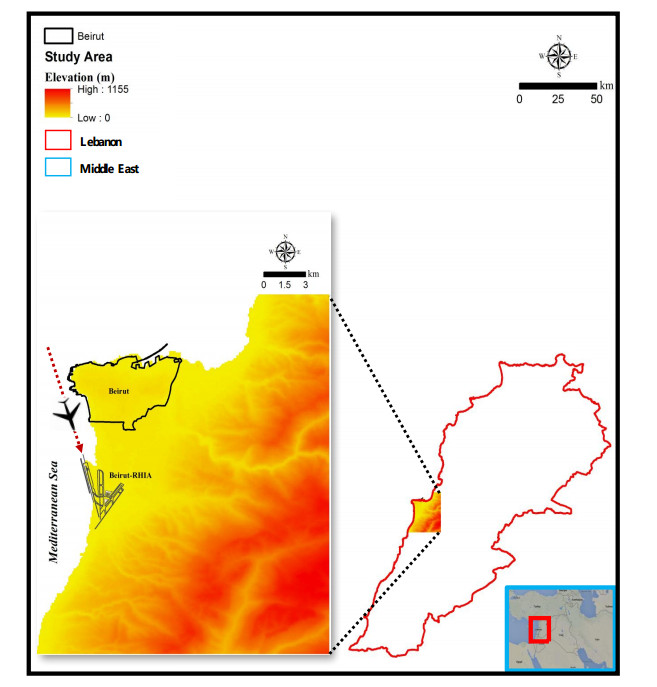









 DownLoad:
DownLoad:
